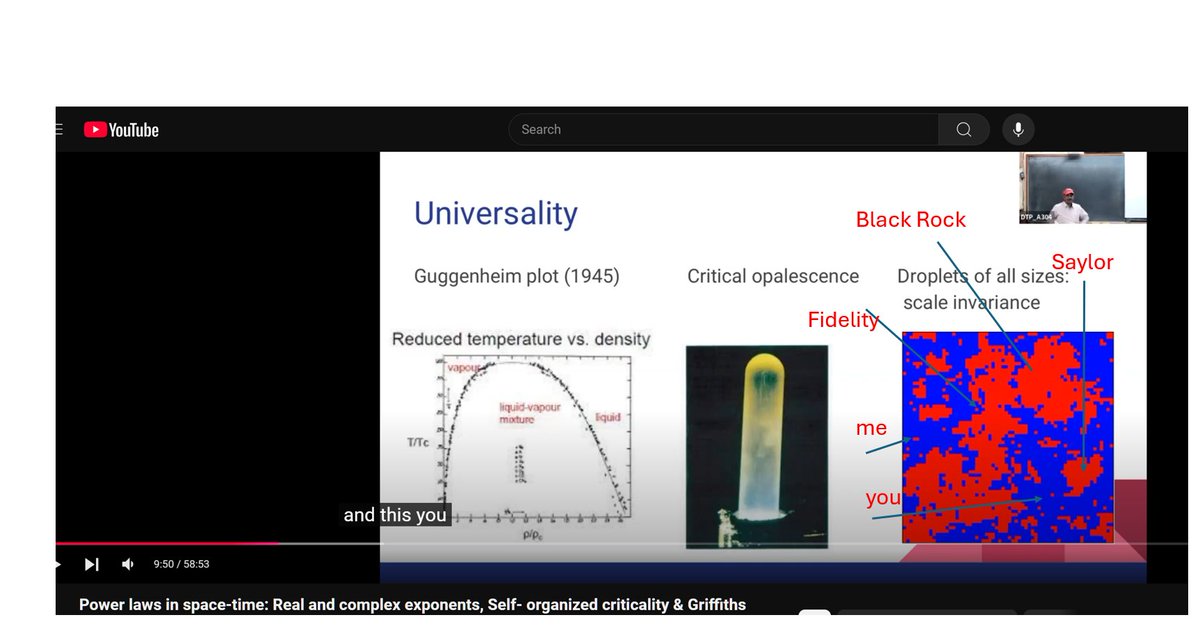I'm working on a detailed article about Bitcoin adoption to clarify the topic once and for all, though misconceptions persist.
But for now let me briefly respond to this post.
1) The Bitcoin power law is not technical analysis (TA).
2) Power laws appear across nature and human systems, often at phase transitions—where matter shifts states, like water freezing into ice. Bitcoin is always on this edge of change, a dynamical chaos.
As water nears 0°C, ice clusters form at all scales, from microscopic to visible chunks. This scale invariance—activity across all sizes—produces a power law when you graph cluster sizes against their frequency.
How does this relate to Bitcoin? The power law reflects agents of all scales—individuals, companies, institutions, even nation-states—interacting in the Bitcoin ecosystem. Their collective non linear actions, across all levels, drive the power law behavior.
Understand that the individuals are many, the institution are few, their action is strong but they are small in numbers so the total effect is the same.
I have already demonstrated, with data, this is the case.
Unlike models with assumptions, the Bitcoin power law is an empirical observation.
But its theoretical interpretation comes to the exact opposite conclusions of the poster.
This is because he doesn't understand the physics of it.
The Bitcoin Power Law suggests this behavior will persist regardless of participant size. In fact, their participation is what guarantees the power law.
Study the Bitcoin power law to truly grasp how Bitcoin functions.

The Great Institutional Bitcoin Suck: Why the Power-Law Model Is About to Explode
Listen to me.
The Power-Law model was built for a world where Bitcoin was a toy.
A cute little rebellion traded by Redditors between bong rips and Doomscrolling sessions.
It NEVER anticipated this.
It never priced in a corporate feeding frenzy so feral it makes Black Friday look like a Quaker prayer meeting.
Right now, public companies, Wall Street ETFs, and rogue sovereigns are hoovering up over four times more BTC per day than miners can dig out of the digital crust.
That’s a liquidity DEATH SPIRAL.
And if you still think the Power-Law chart is going to hold, you might also believe your 401(k) is blue chip stocks and bonds.
What They Didn’t Tell You About the Power-Law:
The model is a relic. It fits Bitcoin’s past price to a tidy formula like some stoned TA bro at a coffee shop:
P(t) = a·tᵇ
Cute. Elegant. Delusional.
It assumes a world where retail speculation drives price.
It’s blind to ETFs. Blind to corporate treasury absorption. Blind to governments storing Bitcoin like it’s oil barrels in 1973.
Projected upper bound for mid-2025? $140K.
Current price? ~$104K.
Historical overshoot margin? 30%.
But here’s the rub: 2017 retail didn’t vacuum up entire mining years of BTC in 4 months.
2025 Demand Shock Breakdown:
Since Jan 1st, 2025:
Corporate treasuries have absorbed 157,000 BTC (about 1,180 BTC/day), or 2.6× the current mining output. Strategy (MSTR) alone accounts for 77% of that.
Spot Bitcoin ETFs have bought 49,000 BTC (about 368 BTC/day), or 0.8× miner output. BlackRock’s IBIT alone logged 19 straight days of inflows.
Governments and miscellaneous entities have absorbed 40,000 BTC (approx. 300 BTC/day), or 0.7× miner output. The U.S. Strategic Bitcoin Reserve is explicitly non-sellable.
Total BTC absorbed YTD: ~246,000 BTC
Daily pace: 1,848 BTC
Multiple of miner output: 4.1×
(Remember: post-halving miner output is ~450 BTC/day)
In just 133 days, institutions removed 82,000 more BTC than miners will create in the entire year.
This Demand Is Sticky. Like, Epstein-Client-List-Level Sticky.
Strategy’s 568,840 BTC is permanent equity capital.
BlackRock’s IBIT and other ETFs can’t sell unless clients redeem shares. 80% of that capital sits in long-term retirement accounts and RIA portfolios.
Trump’s Strategic Bitcoin Reserve is legally locked. It’s not going back on the market.
MetaPlanet is issuing zero-coupon convertible bonds just to acquire more BTC and targets 10,000 BTC by year-end.
This is balance sheet entombment.
Stress-Test: What Happens to the Power-Law Corridor Under 2025 Conditions
Scenario 1 – Continuation (Current pace):
Net buy rate: 1,800 BTC/day
Year-end BTC absorbed: 657,000
Miner supply shortfall: More than 4×
Likelihood of breaking upper Power-Law rail: Very High
Scenario 2 – Moderation (50% slower pace):
Net buy rate: 900 BTC/day
Year-end BTC absorbed: 329,000
Miner supply shortfall: ~1.5×
Likelihood of overshoot: High
Scenario 3 – Saturation (flows stop after August 1):
Total BTC absorbed: 246,000
Supply and demand equilibrium resumes
Likelihood of breaking rail: Lower, but still replicates 2020–2021 dynamics (which pushed BTC 2.3 standard deviations above the model)
Even in the worst-case scenario, the squeeze is violent enough to rip through historical trend rails.
What Blows the Roof Off:
1.401(k) Platform Onboarding – If IBIT and FBTC are added to retirement plans, we’ll see automatic payroll-buy BTC flows.
2.Corporate Copycats – New entrants like GD Culture Group, Strive, and Blockchain Group are raising hundreds of millions just to buy BTC.
3.Second-Order Leverage – Miners are pledging future BTC to raise capital now, reducing spot selling. ETFs are rehypothecating cash collateral into Treasuries.
4.Macro Tailwinds – If the Fed cuts and the G7 goes full money printer again, fiat expands while BTC supply remains fixed.
54
19.92K
The content on this page is provided by third parties. Unless otherwise stated, OKX TR is not the author of the cited article(s) and does not claim any copyright in the materials. The content is provided for informational purposes only and does not represent the views of OKX TR. It is not intended to be an endorsement of any kind and should not be considered investment advice or a solicitation to buy or sell digital assets. To the extent generative AI is utilized to provide summaries or other information, such AI generated content may be inaccurate or inconsistent. Please read the linked article for more details and information. OKX TR is not responsible for content hosted on third party sites. Digital asset holdings, including stablecoins and NFTs, involve a high degree of risk and can fluctuate greatly. You should carefully consider whether trading or holding digital assets is suitable for you in light of your financial condition.


